I have been wanting to try this for years, ever since I tasted home cured olive at my mate George’s house when I was about 12 years old back in my home town of Loxton.
I have three very small olive trees, but I have yet to produce my own fruit as they are just not mature enough. Combined with the fact that I just love olives whether they be green or black, I just needed to get my act together and give it a go. I have noticed many places around our town that have olive tree laden with fruit, and they were just sitting there going to waste, which seemed like a crying shame to me. What to do?
Well first I had to learn to cure olives before I approached anyone for their surplus. So when we visited Talbot Farmers Market, I visited the olive man and asked him if it was easy enough to cure olives. He rambled on a little but I got the gist of it, and it was enough to whet my appetite and seek other curing recipes.
I purchased 1kg (2.2lb) of Sevillano Olives and took them home. After a bit of research I found that there were a few ways to cure olives, one in brine, one in water then brine, and one in lye. I chose the one in water and then brine method as the Sevillano olives are mostly green all the way through, even though they look black, which is a bit deceiving for a beginner like me.
So here is how I went about curing my olives (click to enlarge photos).
Firstly I disregarded any with bruises and blemishes and threw them in the compost bin.
I separated what I thought was the green from the black, as the recipe calls for different soaking times.
Next I used a sharp knife to make a cut lenghtwise on opposite sides of each olive to quicken the soaking process. Try not to cut into the pip. The soaking process removes most of the bitterness from the fresh olive, and anyone who has tried to eat a raw olive will attest to its horrible bitter taste.
So in clean and sterilised spring clip jars, I placed the black and green olives (black at the back and green at the front jars). Then you simply fill each jar to the brim with tap water and then clip down the lid. By ensuring that some water leaks out when you clip it down it is fairly certain that all the olives are entirely immersed. Change the water every day, which is easy with this type of jar. Just release the tension on the clip and drain the water. Then fill up again to the brim with tap water. The recipe I used said that you soak black olives for 4 days, and green for 6 days, however I found that both were too bitter still for my liking and discovered that the black ones were really green olives in disguise! I soaked mine for 14 days until I was happy that most of the bitterness was gone. If you get a little bit of scum on top of the water some days, don’t dispair as this is normal.
Above is the final olives and you can notice that during the soaking process the blackness of this type of olive turned green. So on to the next stage, which is the brineing.
I added two thirds of a cup of salt to 2 litres (~2qts) of water and heated it until disolved. Then transfered to a pyrex jug to make it easier to pour into the jars.
Fill your jars up with brine to just covering the olives.
Some may floats still, so to make it impervious to air, cover with a little olive oil. About 5mm will suffice, enough so the oil is a single layer floating on top.
Then seal the lid with the clip. I left about 1cm clearance so that there was no spillage when I sealed it.
My recipe called to leave these jars for 5 weeks. After waiting period that they are ready to eat. Time will tell. I will sample some mid June and let you know the verdict. Apparently they can store for up to six months like this in the brine, but they last even longer if stored in olive oil. I don’t think that they will last that long if they taste yummy. Ben also loves olives, so it will be a fight to the last one!
Next year, I will ask around and barter for a 10kg bucket of olives from friends and see how we go from there. Until next year.

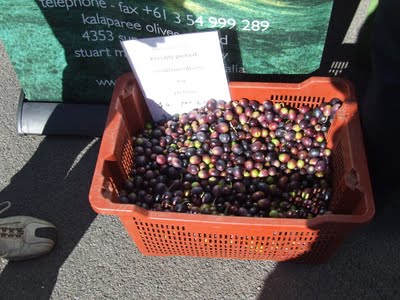
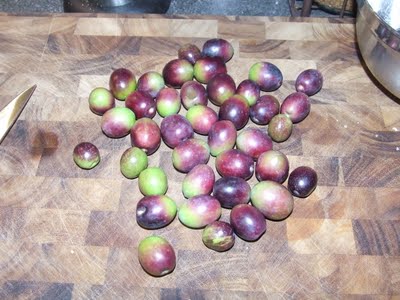
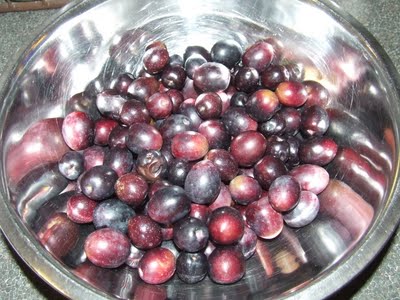
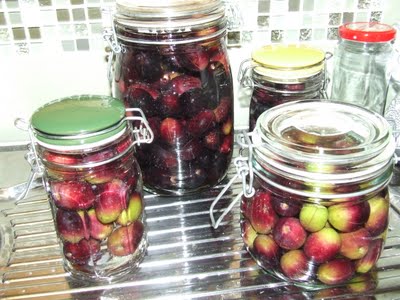
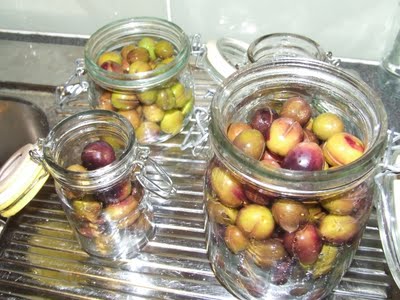 ,
,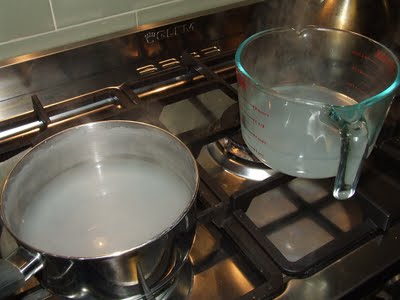
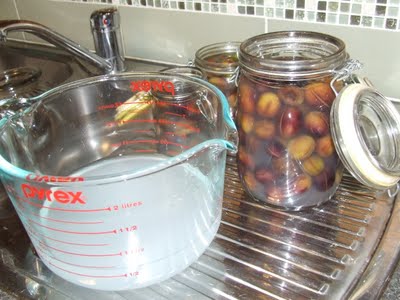

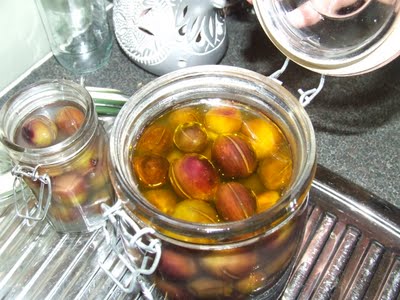
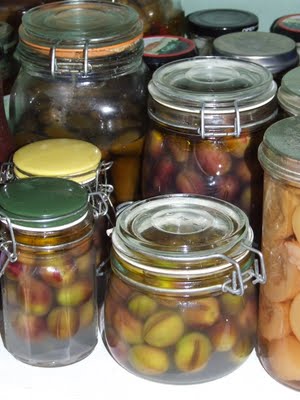
I will await your judgement on the olives with interest. We have three little olive trees up the coast and they have already borne fruit less than 6 months after planting – unlike the 6 year old one we have in our clay soil here.
There aren’t enough to do anything with so far but I’m anticipating a great crop next year. I was a bit horrified to think of putting lye with them so your alternative sounds brilliant, thanks.
I’m sure these will be wonderful and I bet you will have the perfect cheese and beer to accompany the olives.
We’re putting in an olive grove at the farm and, give it a few years, I hope to be doing the same as you’ve just done. Oh, I LOVE olives!
It was my elderly greek neighbour who first put me onto preserving my own olives. I have been astounded at how great they taste – better than any store-bought olives I’ve ever tasted! I soak in brine until almost all bitterness is gone (taste test) and then jar them in a brine/vinegar mix with some olive oil on top.
Since our street trees are olive trees all it costs me is some salt, vinegar and oil. Definitely worth the effort.
Thanks for the great photos and the step by step Gavin.
I used a different curing method last year, when a friend gifted me with three – 4ltr buckets of Kalamata olives from their tree. I sorted the olives, removing bruised or damaged olives, slit them top to bottom as you describe, then placed them back in the buckets. I then mixed a brine solution of 1 cup sea salt (organic) to 10 cups rainwater. I poured the brine over the olives in each bucket (I needed more than one brine recipe to cover them all) and then placed a plate on top of the olives to keep them submerged! Change the brine every 24 to 36 hours (we used our “spent” brine to control the weeds growing between the brick veranda and the house)for one week. At the end of the week, try and press a thumbnail into the flesh of an olive. If your nail goes to the pip, taste the flesh to see if it is to your liking. If not, continue the brining another 3-4 days and try again. Once you are satisfied with the taste, change the brine to a weaker solution of 1/2 cup salt to 10 cups water and bottle the olives, topping each bottle with about 3cm of pure olive oil (the better the oil, the better the taste!). I added herbs and seasonings at this point (fresh rosemary and lemon slices to one lot, garlic cloves that have been bruised and fresh oregano to another lot and just “plain” brine with a bruised garlic clove or two to the last lot). Let sealed jars sit in a cool, dark place for 2 weeks. It was so easy! And every jar was fantastic! 🙂 Hope yours are just as yummy!
Mmmmm Olives……………I love olives.
What a great post, thanks Gav
We are still eating our way through last year’s brine-cured olives, so this year, I decided to try something different and did a run of dry-salted ones. After picking them, we went over them and threw overly soft, blemished or otherwise damaged ones in the compost. Then lined a plastic colander/sieve with a bit of cloth torn off an old sheet, then alternate layers of cooking salt and olives and sat it in a large stainless steel bowl. After a few days, liquid began to seep out through the cloth and the salt got noticibly damp. Each day we gently stirred and mixed them around. Rinsed and sampled one after 2 weeks or so and it was well on the way, but still too bitter. After 4 or 5 weeks or so, they were all shrivelled up, but on sampling, there was only a trace of bitterness and it was all olive (and a touch of salt). Some went into a jar in the fridge with herbs, chillies and just a little olive oil, for immediate consumption. The rest went into the freezer for later. I will be doing this again !
PS: Love the blog, great to see the efforts you have gone to to reduce your footprint. We are on the same path, a bit further ahead on some things maybe, but a long way behind in others. Keep up the good work. Cheers from another worker in the IT trenches
Our company M&CP Farms, http://www.GreatOlives.com, offers fresh raw olives in season for you to cure at home. Due to several factors it will be a short season, which we expect to open to online purchases in the next few weeks. There are lots of ways to cure raw olives, we have included a few on our website in our recipe section.
Thank you for sharing your knowledge, Gavin. I share your sentiments about our beautiful planet and am working along the same lines as yourself!